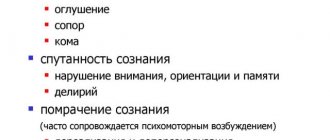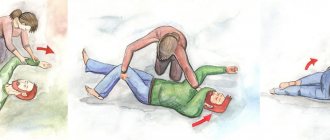The attack passes as unexpectedly as it began. The individual has no memories of him, but sometimes they are fragmentary.
The twilight state of consciousness can last several minutes, days, and sometimes longer. It necessarily requires serious treatment by psychiatrists, since it poses a danger to both the person suffering from it and the people around him. Therefore, in the event of an attack, immediate hospitalization is necessary.
General information
Fainting is also called syncope (this word comes from the Latin word syncope, which, in fact, is translated as “fainting”). The definition of fainting is as follows: it is an attack of loss of consciousness for a short time, associated with temporarily disrupted cerebral blood flow, in which a person loses the ability to maintain an upright position. The ICD-10 code is R55 fainting (syncope) and collapse.
Fainting and loss of consciousness - what's the difference?
However, unconsciousness is not always fainting. The difference between fainting and loss of consciousness is that an unconscious state can develop not only due to a deterioration in the blood supply to the brain, but also due to other reasons.
You can talk about fainting in the following cases:
- The man completely lost consciousness.
- This condition happened suddenly and quickly disappeared.
- Consciousness returned independently and without consequences.
- The patient could not maintain a vertical body position.
If at least one of these points does not correspond to what happened, it is important to conduct an examination to determine the reason for the fainting condition.
Syncope, which is characterized by one or two of the points described above, is sometimes mistakenly considered to be syncope. The condition of syncope may be accompanied by severe manifestations: epilepsy , stroke , heart attack , metabolic disorders, intoxication, cataplexy, etc. In the description, which indicates the ICD-10 code for syncope, a number of manifestations are noted that have similar symptoms, but are not syncope.
What is heat stress (overheating, hypothermia)?
Heat stress is a condition when the body cannot get rid of excess heat. When this happens, your body temperature rises and your heart rate increases.
As the body continues to accumulate heat, the person begins to lose concentration and has difficulty concentrating on any task, may become irritable or sick, and often loses the desire to drink. The next stage most often is fainting and even death if the person has not cooled down.
Factors that contribute to heat stress include high air temperature, radiant heat sources, high humidity, direct physical contact with hot objects, and strenuous exercise.
Pathogenesis
The basis of the pathogenesis of syncope is transient cerebral hypoperfusion , which develops suddenly. Normal cerebral blood flow is 50-60 ml/100 g of tissue per minute. A sharp decrease in cerebral blood flow to 20 ml/100 g of tissue per minute and a decrease in the level of blood oxygenation leads to the development of syncope. If cerebral blood flow suddenly stops for 6-8 seconds, this leads to complete loss of consciousness.
The mechanisms for the development of this phenomenon may be as follows:
- There is a reflex decrease in the tone of the arteries or the functioning of the heart is disrupted, which leads to a deterioration in blood flow.
- tachycardia , bradycardia occur sharply , and episodic cardiac arrest is noted.
- The development of changes in the heart, due to which blood flow is disrupted inside the heart chambers.
- The level of systemic blood pressure - syncope develops with a sharp decrease in the level of systolic blood pressure.
- In older people, this is often associated with narrowing of the blood vessels that supply the brain, as well as heart disease.
- In young patients, fainting is most often associated with dysfunction of the central nervous system or mental disorders - so-called reflex fainting .
Consequently, the development of such a condition due to various reasons is due to different mechanisms of manifestation of deteriorated cerebral circulation. To summarize, the following mechanisms can be distinguished:
- Decreased or loss of vascular tone.
- Reduced flow of venous blood into the heart.
- Reducing the volume of blood circulating in the body.
- Insufficient ejection of blood from the left or right ventricle of the heart into one of the circulation circles, which leads to disruption of cerebral blood flow.
Taking into account the pathophysiological mechanisms, the following types of syncope are distinguished.
Neurogenic
The most commonly developed variety. In most cases, they are not associated with serious illnesses and do not pose a danger to humans. So-called essential syncope sometimes occurs in healthy people, and its causes remain unknown. However, as a rule, they develop in overly emotional individuals against the background of a psychovegetative syndrome. They are associated with a violation of the neurohumoral regulation of the cardiovascular system, which develops due to dysfunction of the autonomic nervous system.
In turn, there are several types of this type of fainting:
- Vasodepressor or vasovagal syncope - this condition develops most often, in about 40% of cases. This occurs due to transient failure of autonomic regulation of the cardiovascular system. Vasovagal syncope begins with an increase in sympathetic tone. This increases blood pressure, heart rate and systemic vascular resistance. Next, the tone of the vagus nerve increases, which entails hypotension. Develops as the body's reaction to stress. It can be triggered by a number of reasons - fatigue, alcohol consumption, overheating, etc.
- Orthostatic - syncope of this type develops mainly in older people, in whom the volume of circulating blood does not correspond to the instability of vasomotor function. In addition, many older people take medications to lower blood pressure, vasodilators, and antiparkinsonian medications, which can lead to the development of orthostatic syncope. It develops when a person very quickly moves from a horizontal to a vertical position.
- Hypovolemic - develops when a person loses a lot of blood due to dehydration (severe vomiting, diarrhea, dry fasting). This results in hypotension , decreased venous return to the heart, and ineffective cerebral blood flow.
- Sinocaratoid - develops if a person has high sensitivity of the carotid sinus. It most often occurs in older men with atherosclerosis and hypertension. Such syncope may be associated with irritation of the carotid sinus when turning the head, wearing tight ties, etc.
- Situational - happens in stereotypical situations - coughing, swallowing, eating, etc. Associated with high sensitivity of the vagus nerve, reflex reactions to irritation and pain.
- Hyperventilation is a consequence of excessive breathing.
Cardiogenic
This type of loss of consciousness is diagnosed in approximately 20% of cases. It develops due to “cardiac” reasons - a decrease in cardiac output, which develops as a result of a decrease in heart rate or stroke volume of the heart. Occurs in diseases of the heart and blood vessels. They are divided into fainting due to arrhythmias and due to obstructive processes in the left half of the heart. In turn, arrhythmogenic syncope is divided into:
- Bradyarrhythmic - syncope conditions develop with a sharp decrease in heart rate to below 20 beats per minute or with asystole lasting longer than 5-10 s.
- Tachyarrhythmic - develops with a sudden increase in heart rate to more than 200 per minute.
Cerebrovascular
A consequence of cerebrovascular diseases with stenotic lesions of the main arteries, metabolic disorders, and the use of certain drugs. In addition, this type of loss of consciousness may be associated with transient ischemic attacks, which occurs most often in older people.
Non-syncopeal forms of short-term loss of consciousness are also distinguished . In some forms of epilepsy, a brief loss of consciousness occurs when the person loses normal motor control, causing them to fall. However, a short-term loss of consciousness for a few seconds is a condition that may be associated with the reasons described above.
Taking into account the pace of development and duration, the following types of disorders of consciousness are distinguished:
- Sudden and short-term (loss of consciousness for a few seconds).
- Sharp and prolonged (for several minutes, hours or days);
- Gradual and prolonged (for a period of several days);
- With unknown beginning and duration.
Sudden brief loss of consciousness
Many people have encountered this. For some people, this process happens so quickly that they don’t even pay attention to it and don’t attach any importance to it, since everything lasts a few fractions of a second, and on a purely physiological level they feel only a slight, barely noticeable dizziness.
Meanwhile, a short-term loss of consciousness for a few seconds is very dangerous, since it is often accompanied by a violation of the sense of spatial orientation, balance and, as a result, a fall, or a lack of coordination of movements (if the body is in a horizontal position, or the person is simply sitting) .
For example, if you are crossing the road, working at a machine, walking across a bridge, driving a car, and so on, then losing consciousness at this time, even for a very short time, is fraught with many negative consequences not only for you personally, but also for many people around.
For example, in the 19th century, girls often fainted because of fashion. At that time, thin waists were fashionable, and girls laced their corsets too tightly. As a result, the vessels are pinched. This even found a place in painting.
Therefore, you should figure out what reasons can provoke such conditions, what to do if this has already happened, which specialist is best to contact, and so on.
Causes of fainting
The causes of loss of consciousness are associated with various diseases and conditions of the body. Thus, sudden loss of consciousness can be associated with diseases of various body systems - nervous, endocrine, respiratory, cardiovascular, as well as with other phenomena - taking medications, excessive physical activity, overheating, etc.
Speaking about what causes people to faint, we can distinguish the following groups of reasons:
- “Benign”, that is, not associated with serious problems. When answering the question of what causes you to faint, you should not discount some natural causes that lead to a short-term cessation of oxygen supply to the brain. This, for example, can happen if a person stands for a long time or lies in a forced position, abruptly gets up from a lying position or unbends. Frequent fainting due to this reason is typical for some pregnant women, elderly people, patients with varicose veins and atherosclerosis.
- Associated with hypotension. People who have low blood pressure often lose consciousness compared to those whose blood pressure levels are normal. Fainting is highly likely to develop in those who suffer from vegetative-vascular dystonia, due to which regulatory vascular mechanisms are disrupted. In such people, the impetus for the development of syncope can be severe stress, severe pain, etc.
- As a consequence of problems with the cervical spine . With osteochondrosis of this part of the spine, the venous outflow and blood supply to the brain are disrupted. Sudden fainting in this case is possible due to sudden turns of the head or squeezing of the neck.
- Consequence of cardiac arrhythmia. The answers to the question of why people faint may be more serious. One of these causes is arrhythmia, in which the rhythm, frequency or sequence of heartbeats is disrupted. This can happen with high blood pressure as a result of tachycardia. In this case, it is important to consult a doctor so that he can determine whether loss of consciousness is a symptom of what disease. In people with heart and vascular diseases, loss of consciousness is a symptom that requires an immediate visit to a specialist.
- Pulmonary embolism . This is a very serious condition in which the pulmonary artery is blocked by a blood clot that has broken off from the walls of the vessels of the lower extremities.
- Pregnancy. Causes of fainting in women may be related to pregnancy. Often expectant mothers experience hypotension due to hormonal changes in the body or, conversely, increased blood pressure due to impaired blood flow. Physiological changes in the body can also lead to loss of consciousness in women. As the unborn baby grows, the amount of blood circulating in a woman’s body increases, and while he adapts to such changes, this can lead to fainting. This is also possible due to toxicosis . In girls, syncope due to changes in the body can appear during puberty.
- Powerful emotions. In both men and women with psycho-vegetative instability, syncope can occur under severe stress, nervous shock and an excess of emotions. In this case, the answer to the question of how to cause fainting is simple. A susceptible person can bring himself to such a state with elementary things for others, since, for example, the sight of blood or an emotional quarrel can provoke syncope in them. In this case, a person may experience a state of “As if I’m going to faint” for a short period, after which syncope occurs. You should ask your doctor about how to prevent fainting in this case.
- Development of tumors in the brain. In this condition, the patient’s tumor compresses the blood vessels and nerve endings, resulting in fainting with convulsions, and such attacks are repeated quite often. This is a very alarming syndrome that should be addressed to a doctor immediately.
- Epilepsy . The causes of loss of consciousness and seizures may also be associated with epilepsy. In this case, episodes of loss of consciousness and convulsions appear suddenly. Although attacks can occur without convulsions. The so-called petit mal seizure is a condition where there is a loss of consciousness with the eyes open. It lasts for several seconds, while the patient’s face turns pale and his gaze focuses on one point. The disease requires complex treatment that will help reduce the number and frequency of attacks.
In addition, if an adult or child faints, the reasons may be as follows:
- Taking a number of medications - antidepressants, nitrates, etc.
- Poisoning with toxins , alcohol, carbon monoxide.
- Anemia.
- Bleeding – uterine, gastrointestinal, etc.
- Neuroinfection.
- Liver and kidney failure .
- Diseases of the heart and blood vessels.
- Metabolic disorders.
- Neurological diseases.
Loss of consciousness may be due to the following reasons:
- neurogenic (change of body position, during sports training, staying in a stuffy enclosed room, etc.);
- stress, severe pain, leading to a decrease in blood flow to the heart;
- cardiovascular diseases;
- blood clots;
- anaphylactic shock;
- uncontrolled increased breathing or deep breathing, for example, during panic attacks, fear;
- poisoning;
- brain pathologies;
- disturbances in the normal functioning of the autonomic nervous system;
- epilepsy;
- fasting;
- lung diseases;
- hypotension, hypertension (sudden loss of consciousness, blood pressure drops or rises sharply);
- diabetes mellitus;
- emotional excitement (especially in young children);
- menstruation, menopause, etc.
Symptoms and signs of fainting
Very often, syncope occurs suddenly. But sometimes signs of fainting can be noticed in a timely manner and loss of consciousness can be prevented. When you feel faint, the following symptoms appear:
- excessive sweating;
- impending nausea;
- pale skin;
- dizziness and sudden manifestation of severe weakness;
- darkening in the eyes, the appearance of “floaters” before the eyes;
- noise in ears;
- frequent yawning;
- numbness of arms and legs.
If such symptoms are noticed in a timely manner and immediately sit down or lie down, the blood in the vessels will quickly be redistributed, the pressure in them will decrease, and syncope can be prevented. If fainting does occur, then the person will at least protect himself from falling.
The immediate signs of fainting in a person are as follows:
- Extremities become cold.
- The pulse slows down.
- The pupils will dilate or constrict.
- The pressure decreases.
- The skin turns pale.
- The person breathes irregularly and at a lower rate than usual.
- The muscles suddenly relax.
- With prolonged syncope, the muscles of the face and torso may twitch.
- There may be severe drooling and dry mouth.
This state does not last long - from a few seconds to 1-2 minutes. In this case, breathing and heartbeat do not stop, involuntary urination and defecation do not occur, and there is no urge to vomit.
The symptoms of hungry fainting, which occurs due to a lack of nutrients in the body, are similar. Hunger fainting occurs in those who practice very strict diets or prolonged fasting. Such symptoms indicate that nutrition must be adjusted immediately, since hungry fainting is evidence of a deficiency in the body of substances important for its functioning.
Brief loss of consciousness due to a fall
Fainting is a word used to describe loss of consciousness. But this essentially means the same thing. The fainting state lasts from several seconds to several minutes, otherwise it makes sense to consider the patient’s condition as a coma. With fainting, a longer-term loss of the brain's ability to remain conscious is very rare. The most common types of fainting are:
- - vasovagal syncope (sharp dilation of blood vessels and slow heart rate);
- - hyperventilation syncope;
- - associated with hyperkinetic syndrome (HKS);
- - cough syncope;
- - nocturic (occurs in men);
- - hypoglycemic (lowering blood glucose);
- - orthostatic fainting (sudden transition from horizontal to vertical position)
- - traumatic (due to injury, cow circulation is impaired) and so on.
What is typical is that in the vast majority of cases, almost every fainting spell, lipothymia is noted. This is a specific condition, also called “presyncope.” It is accompanied by a deterioration in health, darkening of the eyes (short-term blurred vision and loss of consciousness are very closely related), dizziness, rapid breathing, impaired sense of balance and other symptoms.
If loss of consciousness is accompanied by a fall, then syncope should be considered among the first causes of such pathology. Blood flow can be permanently disrupted, but when, suddenly, the volume of blood that is delivered to the brain decreases even more, loss of consciousness (fainting) occurs and, as a result, a fall occurs.
For example, if a patient suffers from osteochondrosis, then blood flow is usually impaired. A person may practically not feel this, since he lives with it all the time and is already accustomed to this condition. But as soon as the vessels are compressed even more strongly, for example, when turning the head sharply, the blood volume for the brain becomes catastrophically small, and syncope is an almost inevitable result of such a development of events.
Syncope can be caused by a large number of factors. Let's look at the most common ones among them!
1. Fainting of a neurotransmitter nature. Human blood pressure is regulated by the autonomic nervous system. With a sharp change in its activity (when it shows hyperactivity), bradycardia may be observed, and less often - expansion of the lumen of blood vessels, including those leading to the tissues of the brain (which, as we know, controls our consciousness).
This can already serve as fertile ground for fainting. But when these two states are observed at once (complexly, simultaneously), then loss of consciousness, accompanied, naturally, by a fall, occurs very often.
2. Hypotension of the orthostatic type. It is based on the following mechanism: when the body moves from a vertical to a horizontal position, blood pressure in the body, and in particular in the brain, sharply drops by 20 millimeters of mercury or more. The load on the heart increases as blood, under the influence of the Earth's gravity, flows to the chest from the head.
The heart muscle slows down for a very short period of time, which further aggravates the situation, reducing blood circulation against the background of already extremely low pressure. The body of a healthy person reacts adequately to such situations, and the pressure remains practically stable even with a very sharp change in body position.
But in a sick person, or in elderly people, everything happens exactly as described above. The situation can be complicated or provoked initially by Parkinson's disease, diabetic neuropathy, orthostatic hypotension, side effects of taking pharmaceuticals, amyloid neuropathy, alcohol abuse or smoking, and so on.
3. Arrhythmia of the heart muscle. It manifests itself in disruption of the heart: deviation of the rhythm of its contractions from the natural, normal one. It can suddenly beat either too quickly or, on the contrary, too slowly. This disrupts the perfusion of brain tissue, causing loss of balance, sense of spatial orientation, falling, and so on.
Heart rhythm disturbances often result from: sinus tachycardia, sinus bradycardia, ventricular tachycardia and other causes. Arrhythmia is not a very common cause of syncope, but it makes sense to consider it as a possibility.
4. Syncope from cardiac, pulmonary or cardiopulmonary disorders. We are talking about acute conditions! Since the circulatory and respiratory systems are the main links in terms of saturating the brain with oxygen. When something goes wrong with them, he suffers too.
Among them: heart disease, pulmonary hypertension, myocardial infarction, hypertrophic cardiomyopathy and others. Such conditions usually require immediate hospitalization and emergency qualified medical care.
5. Fainting caused by a serious disruption of blood circulation in the brain itself. The reasons are also varied: from previous injuries to blockage of blood vessels due to the presence of blood clots or cholesterol plaques.
Tests and diagnostics
To determine why a person is losing consciousness, the doctor takes the following steps:
- Performs initial condition assessment. To do this, anamnesis is collected or, if necessary, an interview with eyewitnesses is carried out. It is important to find out whether an episode of loss of consciousness or multiple fainting episodes actually occurred.
- Takes into account the likelihood of psychogenic attacks or epileptic seizures and carries out differential diagnosis.
- Orders the necessary studies.
In the diagnostic process, if necessary, the following methods are practiced:
- Physical examination.
- Electrocardiogram.
- Daily ECG monitoring.
- Ultrasound to determine structural changes in the heart.
- Orthostatic test.
- Clinical stress test to determine myocardial hypoxia
- Coronary angiography.
- Blood test with determination of hematocrit, hemoglobin , oxygen saturation, troponin level, etc.
If necessary, other studies and laboratory tests are prescribed.
Procedures and operations
If vasovagal syncope recurs frequently, it is recommended to increase your fluid and salt intake.
People who are prone to reflex fainting are taught to recognize the signs of presyncope and take steps to prevent loss of consciousness. They are also advised to change their lifestyle and avoid the influence of provoking factors.
In some cases, no special treatment is required.
In general, the choice of treatment tactics depends on what specific problem caused the disturbance of consciousness.
How the body reacts to high temperatures
Four environmental factors influence the level of stress a worker experiences in a hot work area: temperature, humidity, radiated heat (such as from the sun or furnace), and wind speed. People with high blood pressure or certain heart conditions and people who take diuretics (water tablets) may be more sensitive to the effects of heat. Measuring the climate in the workplace is the first step towards preventing heat stress-related illnesses.
The body protects itself from heat through three mechanisms: breathing, sweating, and changes in blood flow. The first reaction is blood circulation to the skin, which raises the skin temperature and allows the body to release some heat. During hard work, muscles need more blood flow, which reduces the amount of blood available to reach the skin and generate heat.
Sweating also helps the body cool down, but only when humidity levels are low enough to allow sweat to evaporate and if the water and salts lost through sweating are replaced.
Treatment with folk remedies
The use of some folk remedies can help reduce the incidence of syncope. However, these methods are not methods of treating the causes of loss of consciousness, but only auxiliary methods to improve the condition.
- Gentian decoction. To prepare a decoction of this herb, you need to take 2 tsp. crushed raw materials and pour 1 tbsp. boiling water Drink half a glass before each meal.
- Burdock compresses. A fresh burdock leaf should be mashed and placed on the solar plexus. The compress helps you come to your senses after fainting.
- Soothing tea. It helps if a person loses consciousness due to dysfunction of the nervous system. To prepare it, you can take mint, lemon balm, St. John's wort, linden in equal proportions, mix the crushed raw materials, and 2 tbsp. l. pour 2 cups boiling water. After 20 minutes, strain and drink 2 times a day, 1 glass.
- Wormwood oil. Grind 25 g of wormwood seeds in a coffee grinder and pour in 100 g of olive oil. After a day, pour into a dark glass jar and store the product in the refrigerator. Take 2 drops 2 times a day (drop onto sugar).
- Infusion of mountain arnica. 3 tbsp. l. Pour dried arnica flowers into a thermos and pour 200 g of boiling water. After an hour, strain and drink with milk 4 times a day, adding 1 tbsp to 100 g of milk. l. infusion.
- Means for normalizing blood circulation. If loss of consciousness does occur, then after this the person should be given a glass of warm tea or chamomile decoction. Coffee or 1 tbsp will also work. l. cognac to normalize blood circulation.
- Massage of special points. In case of fainting, a massage of the points above the upper lip and under the lower lip will help revive the patient. You need to press hard on them, as sharp pain helps improve blood circulation in the brain. You can also rub the skin in the stomach area for this purpose.
- Cold water. It is sprayed on someone who has lost consciousness. This is especially important if the syncope is caused by overheating. It is recommended to cool the extremities. Also, a person who has come to his senses should drink some cold water in small sips.
First aid for fainting
Everyone should know how to provide first aid for fainting, since such cases can occur in different situations. The correct sequence of first aid actions for fainting is very important, since adequate first aid will help to avoid more serious problems.
The algorithm of actions used to provide emergency care for fainting and loss of consciousness should be as follows:
- If a person faints, then those who are nearby must first lay him down so that his legs are higher than the level of his head and body. This first aid is practiced if the patient is breathing and his pulse is palpable.
- Next, the PMP consists of quickly unfastening those clothes that are constricting the body. We are talking about a belt, a collar, a bra.
- A person needs to put a wet, cold towel on his forehead or simply wet his face with water. Such actions in case of loss of consciousness will help to narrow the blood vessels and restore cerebral blood flow.
- Apply ammonia or strong-smelling cologne to the victim’s nose.
- If the victim is vomiting, his body must be placed in a safe position so that he does not choke, or simply turn his head to the side. Lying on your side will help prevent airway blockage, as syncope can cause the tongue to relax.
- Provided that a person remains unconscious for several minutes, he needs emergency medical care. In this case, most likely, we are not talking about ordinary fainting.
- Nitroglycerin should not be given to a person .
It is important not only to correctly provide first aid in case of fainting, but also to provide first aid after the victim has regained consciousness. What to do after fainting depends on the patient’s feelings. If he still feels dizzy or other unpleasant symptoms, you should leave him lying with his legs elevated. It is worth preparing hot tea or coffee for the victim. Chamomile tea will also work. When the patient feels better, you need to help him get up, doing it slowly and gradually.
First aid for fainting
Despite the fact that adequate first aid in case of loss of consciousness helps the victim to recover quickly, it is still necessary to visit a doctor if such episodes occur frequently. After all, only if the cause of such manifestations is determined can one say exactly what to do in case of fainting and how to cure the cause that provokes it.
It is recommended to call emergency help, since only professionals can distinguish fainting from coma and determine how dangerous the patient’s condition is.
What to do after sudden loss of consciousness
Naturally, help in each specific case will be different, since specific actions and their algorithm depend on the cause of fainting. But there are also general rules that can help a person who has lost consciousness in an emergency. First of all, you should call an ambulance.
Should I help a person who has fainted on my own, without having any special education or even basic knowledge of providing emergency care? This is a rhetorical question. It all depends on the situation.
If, for example, you know that an ambulance is on the way, and the situation does not require urgent drastic measures, there is no need to do anything, just wait near the patient until specialists arrive.
If a person, for example, has lost consciousness and is in a place or position that in a particular situation threatens his life or the lives of others, then measures must be taken, but very carefully, since he may have injuries to the musculoskeletal system or internal organs obtained during a fall.
Although, as a rule, when fainting, the body relaxes so much, becoming relatively flexible, that the person gets away with only minor bruises. How exactly can you help:
- move the person to a safe place;
- if he is lying on his stomach, turn him over onto his back;
- raise your legs up, very carefully, to improve cerebral circulation;
- sprinkle his face with fresh water;
- provide him with a flow of fresh air.
But, once again: taking any radical actions without understanding the situation is fraught with negative consequences. Therefore, in most cases, it is advisable to simply provide the patient with shade (if it is a hot day), provide a flow of fresh air to him and sprinkle his face with water, while still waiting for the doctors.
If we are talking about helping yourself, then this, a priori, is impossible until you come to consciousness. After this, you should call for help. If there is no one nearby, you need to very slowly, but without excessive strain on the muscles of the limbs, get up and slowly walk to the nearest place where you can sit down until you fully come to your senses.
It should be in the shade and in the fresh air. Breathe slowly, but deeply. If possible, contact friends or family who can find you and help you get home. As soon as possible, especially if fainting is regular, try to contact a specialist - an experienced, qualified physician.
Prevention
To prevent loss of consciousness, the following rules of prevention should be followed:
- Drink enough fluids.
- Do not consume alcohol during the hot season.
- Hypertensive patients need to correctly select medications for treatment by visiting a doctor, and adequately adjust their amount.
- Do not stay in a vertical position for a long time. If there is such a need, you need to constantly shift from foot to foot, tensing your muscles.
- If you feel like you are about to pass out, you should sit or lie down immediately to help distribute blood throughout the body or at least prevent you from falling. If you can’t lie down, you should cross your arms and legs, straining your muscles at the same time.
- Avoid exposure to factors that provoke fainting. We are talking about dehydration, wearing tight clothes, overheating, severe emotional shock, etc.
- Visit your doctor in a timely manner to diagnose the development of diseases in a timely manner. It is important to properly and promptly treat illnesses that cause syncope.
- It is better to sleep in a position where your head is elevated. An additional pillow is suitable for this.
- People with vascular problems should wear compression stockings.
- It is necessary to practice adequate exercise and eat right.
Fainting in women
The causes of loss of consciousness in women may be associated with the following problems:
- Internal bleeding as a consequence of diseases of the genitourinary system.
- Too strict dietary restrictions and fasting.
- Pregnancy.
- Too much emotional shock.
It is advisable to consult a doctor if a woman suddenly faints. The reasons for syncope in girls and women are most often harmless. But the development of serious diseases should still be excluded.
Brief loss of consciousness
A person's consciousness is one of the greatest values he possesses. And we are not talking about social, political, or any other consciousness, but about a completely material, concrete - physiological, that is - the ability of the brain and central nervous system to adequately perceive and respond to the external environment, being in an active, waking state (phase) . This is extremely important, as it allows the brain to work fully, and a person to remain fully functional, in every sense. But, sometimes, some people have to deal with a short-term (in some cases, a few seconds) loss of consciousness.
Syncope , as this condition is also very often called, is a sudden, but short-term, fainting, the cause of which is a decrease in the volume of oxygen supplied to the brain tissues due to impaired blood flow or a decrease in its concentration (oxygen) in the blood.
In children
If a child faints, the causes of this phenomenon may be associated with both diseases and age-related changes. Most often, syncope manifests itself in a teenager, since during this period the process of puberty actively occurs, which leads to changes in the body. As experts who study syncope in children note, girls are more susceptible to fainting. Most often, such manifestations are observed in children aged 10-12 years. Young children lose consciousness very rarely.
Despite the fact that this phenomenon may be temporary, if a teenager often faints, the reasons must be determined by a specialist after conducting a study. It is important to find out whether a child who often faints suffers from epilepsy or other serious illnesses. In most cases, we are talking about the reflex nature of such conditions in children. Potential health hazards are reported relatively rarely. But it is still better to consult a doctor and follow his advice.
What to do to avoid short-term loss of consciousness
If you feel that you are about to faint (this is usually felt in advance), you should immediately take a sitting or lying position and call for help. There is no need to be nervous, this can make the situation worse. Breathe evenly and deeply, drink a couple of sips of water.
In terms of recommendations for the general strengthening of the body, we can advise: hardening, normalizing the daily routine, eliminating any stressful situations from your life, as far as possible, cleaning blood vessels, giving up bad habits, leading an active lifestyle, and so on. Naturally, general strengthening measures should not contradict possible contraindications. Be healthy!
Fainting during pregnancy
This condition may be one of the signs of pregnancy. Dizziness and fainting during early pregnancy can occur as early as a few weeks after conception and be a reason for a test.
The answer to the question of why pregnant women faint is the changes that occur in the female body from the first days of pregnancy. Loss of consciousness during pregnancy occurs due to a sharp decrease in blood pressure provoked by hormonal changes. Most often, fainting during pregnancy occurs in women suffering from hypotension .
Various factors can lead to a drop in blood pressure during pregnancy - severe stress, exacerbation of chronic diseases, colds , overwork. Also, the cause of loss of consciousness can be a sharp drop in blood sugar, which occurs due to poor nutrition or malnutrition.
If such a phenomenon occurs once, it should not cause much concern to the expectant mother. But if syncope occurs systematically, you should definitely tell your doctor about it.
To avoid such unpleasant manifestations, the expectant mother should follow some important rules:
- Do not stay for too long in places where it is very hot and stuffy, do not travel in the heat on public transport.
- Do not starve: nutrition must be correct, you need to eat often and in small quantities.
- Do not get up abruptly from a sitting or lying position - this should be done slowly and smoothly.
- Walk more in the fresh air and get a good night's sleep.
- Do not be alone if you are prone to dizziness and loss of consciousness.
Brief loss of consciousness for a few seconds causes
Among the reasons for loss of consciousness for a few seconds, the main one is syncope (impaired oxygen supply to the brain). This is one of the main reasons.
But, cases of loss of consciousness are also possible for a longer period, from several seconds to several minutes. These include:
- generalized epileptic seizure (as a rule, it lasts longer than 1 minute);
- intracerebral bleeding (hemorrhage);
- subarachnoid hemorrhage;
- thrombosis of the basilar artery;
- traumatic brain injuries of varying severity, as well as spinal injuries;
- metabolic disorders;
- exogenous intoxication;
- psychogenic seizures and so on!
Diet
Diet for the nervous system
- Efficacy: therapeutic effect after 2 months
- Timing: constantly
- Cost of food: 1700-1800 rubles per week
Nutrition for people prone to fainting should be complete and varied. To choose the right diet, first of all, you need to find out the cause of such manifestations. The diet is formed depending on the presence or absence of heart disease, vascular disease, diabetes mellitus , etc. The basic nutritional rules should be as follows:
- The menu should be dominated by fresh and properly processed products.
- The diet should be varied to provide the body with essential microelements and vitamins .
- It is better to eat food 5-6 times a day in small portions to prevent the feeling of extreme hunger.
- If the state of the body allows, you need to introduce as many vegetables and fruits into your diet as possible.
- Proper drinking regime is necessary, because dehydration can also cause fainting.
If a person experiences reflex fainting, he should adhere to the principles of a diet for the nervous system .
Which doctor will help?
It often turns out that the first doctor you have to contact is an ambulance worker. Further, if necessary (depending on the causes of fainting), the patient can be sent to a hospital, where he is treated by a general practitioner. Depending on the situation, completely different specialists can be involved in the treatment process: a surgeon, a neurologist, a psychiatrist, a cardiologist, an endocrinologist, an infectious disease specialist and others.
If it turns out that the cause of fainting is a sharp emotional shock (for example, stunning news), which also often happens, or, for example, physical exhaustion of the body as a result of an infectious disease or heavy stress, then, in such cases, hospitalization may not be required.
Consequences and complications
The consequences of such a condition depend on the causes of its occurrence. The most serious consequences may be:
- Development of coma and cerebral edema , which leads to disorders of important life functions.
- Suffocation due to retraction of the tongue in an unconscious state.
- Various injuries received during a fall.
With frequent manifestations of this condition, a person sometimes has to change his occupation.
Forecast
According to medical statistics, in approximately 93% of cases, benign fainting occurs with a favorable prognosis, which does not require drug treatment.
An unfavorable prognosis is observed in those patients in whom fainting is provoked by cardiovascular disease . These people are at risk of death due to heart problems. Risk factors for sudden death in patients with syncope are as follows:
- Age over 45 years.
- Ventricular arrhythmias.
- Heart failure.
- The presence of pathological changes on the ECG, which indicate arrhythmogenic disorders.
- Myocardial infarction.
- Hypertrophic cardiomyopathy.
- Arrhythmogenic right ventricular cardiomyopathy.
List of sources
- Bova A.A. Syncope in clinical practice: educational method. allowance. – Mn.: Asobny, 2009. – 45 p.
- Autonomic disorders: Clinic, treatment, diagnosis / ed. AM Wayne. – M., 1998. – 752 p.
- Guseva I.A., Bondareva Z.G., Miller O.N. Causes of syncope in young people // Ros. cardiology journal. - 2003. - No. 3. — P. 25-28.
- Stykan O.A. Akimova G.A. Differential diagnosis of nervous diseases: a guide for doctors. - St. Petersburg: Hippocrates, 2000. - P. 132-177.










